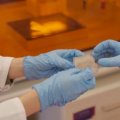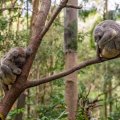A University of Queensland study into island dingo populations shows the species could disappear over most of Australia within 50 years.
School of Veterinary Sciences lecturer Dr Peter Woodall said a study on Fraser Island showed the inter-breeding of wild dogs with dingoes would cause dingo extinction 'by genetic stealth', a process also underway on the mainland.
'There's going to be a gradual lessening of the pure dingo stock,' he said.
'One factor is that pure dingoes breed once in a year, whereas hybrids are more like the domestic dogs and breed twice a year so they're likely to reproduce fast. If that sort of process goes on, settlement increases, and dingoes come into contact with dogs there's a danger that pure dingo stocks will, sometime in the future, be lost.'
Dr Woodall conducted the unfunded Fraser Island study in collaboration with Dr Peter Pavlov of the Queensland Lands Department and Keith Twyford of the Queensland Department of Environment and Heritage. He said the research project was begun 'because everyone said Fraser Island was a bastion of pure dingo stocks, but no-one had ever looked at it scientifically'.
Their examination of 30 Fraser Island dingo skulls at the Queensland Museum showed a third of the 'dingoes' in the island's south were wild dogs or hybrids.
In the north, however, there was a high frequency of pure-breds - at around 95 per cent, one of the purest lines in Australia. Overall, about 80 per cent of dingoes on the island were pure-bred.
Dr Woodall said the pure stocks in the north were due to fewer people and because the territorial nature of the packs cut intermingling. But the hybrids would gradually take over the gene pool, and a system of positive identification was needed so wild dogs could be culled.
'We need a DNA test so that an animal can be caught and held while it is tested,' he said. 'At the moment, the only way to tell is by measuring parts of the skull, which obviously has to be done when the animal is dead.'
The teeth and one part of the ear are distinctive in dingoes, he said.
'You can't tell them apart by looking at them. Hybrids and dingoes often look exactly the same. Coat colour can be deceptive. For example, many people think of the dingo as tan. But some pure dingoes are black,' he said.
Dr Woodall said that elsewhere in Australia a similar pattern was emerging. Of 100 skulls lodged at the museum, the highest frequency of dingoes (95 per cent) was found in a sample from Augathella, an isolated community in central Queensland.
Where there were higher rates of human occupation and residence such as south-eastern Queensland, the percentage of dingoes was only 50 per cent, which is also the rate in southern states.
'I think it's a matter of trying to preserve the native dingo in Australia. We need to find the areas where they are pure and protect them because there's a danger that we may lose them,' he said.
'Apart from the general need to preserve species, the dingo is the largest carnivore in Australia and controls a lot of animals - kangaroos, wild pigs and rabbits.'
Dr Woodall said further studies could be run to determine whether hybrids and wild dogs were more aggressive than dingoes.
Currently, it was unknown whether dingoes or wild dogs posed a greater threat to stock or humans at Fraser Island.'
The dingo, Canis lupus dingo, is found throughout mainland Australia and is believed to have been introduced by Asian visitors 3000-4000 years ago. Identical to an Asian wolf found in south-east Asia, it is different from domestic dogs but there are frequent matings between the two and hybrids are fully fertile.
Dr Woodall has now extended his study to dingoes on Bribie Island.
For further information contact Dr Peter Woodall telephone 3365 2300.
.jpg)



